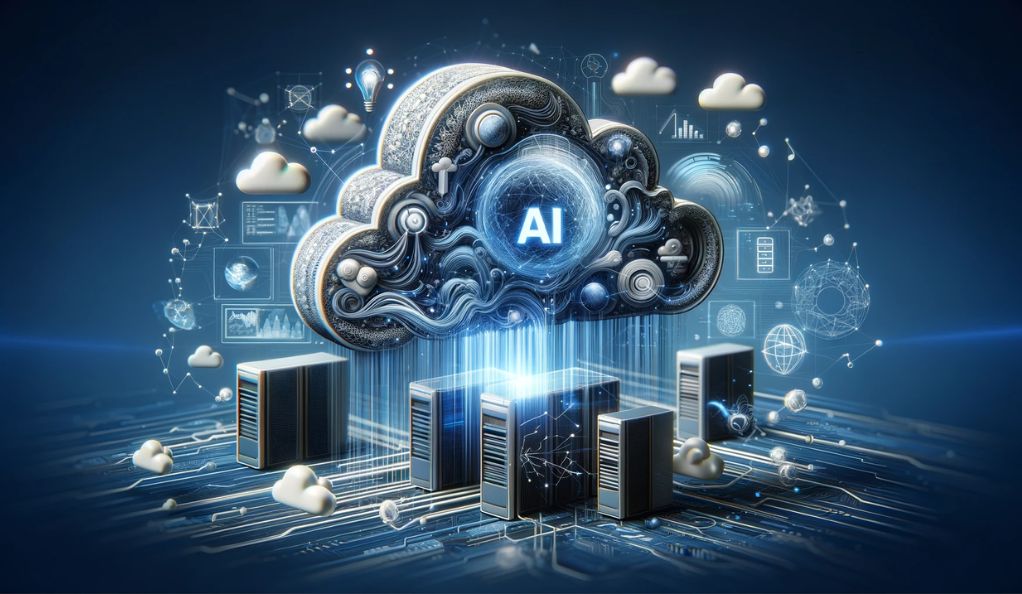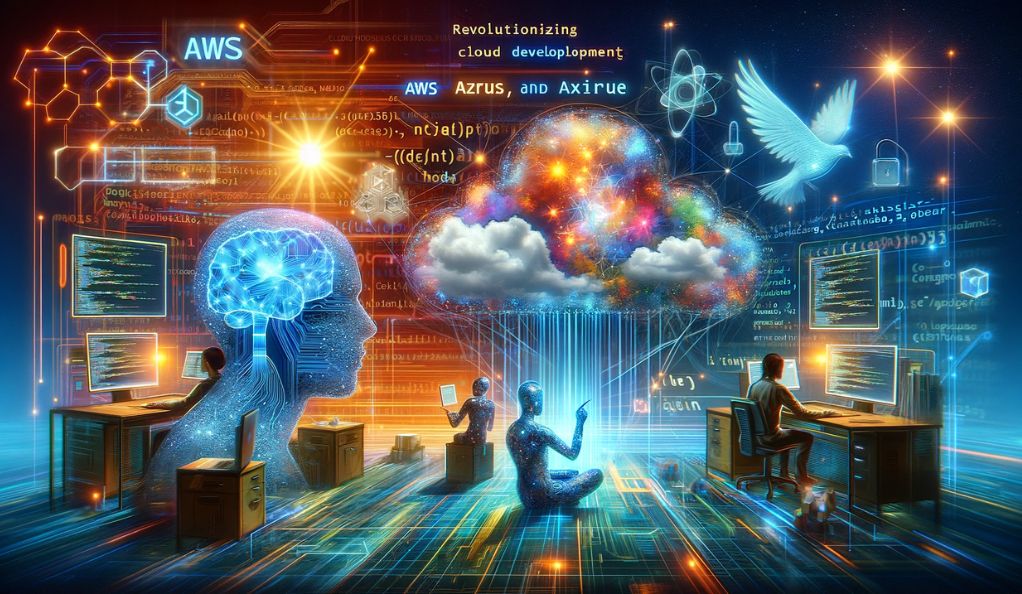The amalgamation of Artificial Intelligence (AI) and cloud computing marks a pivotal advancement in technology. This blend is revolutionizing software development, integrating AI’s analytical prowess with the cloud’s computational capabilities. Key players like AWS, Azure, and GCP are at the forefront, offering diverse AI and Machine Learning tools. This synergy is not just enhancing data processing but is also paving the way for innovative solutions across various sectors. This article explores how this powerful combination is shaping the future of technology, focusing on AI-driven coding in cloud platforms.
Understanding AI and Machine Learning: Basics for Cloud Developers
Artificial Intelligence (AI) and Machine Learning (ML) are often used interchangeably, but they have distinct definitions and roles, especially in cloud computing. AI refers to the broader concept of machines being able to carry out tasks in a way that we would consider “smart”. It’s the pursuit of simulating human thought and decision-making in an automated fashion. On the other hand, ML, a subset of AI, involves giving computers the ability to learn and adapt through experience without being explicitly programmed. This is crucial in the context of cloud computing, where vast amounts of data can be processed and analyzed.
Key Components of Machine Learning in Cloud Computing:
- Data: The foundation of any ML project. Cloud platforms provide the capability to handle and analyze massive data sets.
- Computational Power: Necessary for processing data and running complex algorithms. Cloud platforms offer scalable computing resources to meet these demands.
- Algorithms: The set of rules or instructions that ML models follow to learn from data and make predictions or decisions.
- Knowledge and Expertise: Understanding the principles of ML and how to apply them effectively in the cloud environment.
In the past, the resources required for ML were limited to governments and large institutions due to high costs and complexity. However, cloud computing has democratized access to these tools, allowing anyone with an internet connection to utilize powerful ML technology. This is largely thanks to the development of user-friendly platforms and services by cloud providers like AWS, Azure, and GCP, which offer point-and-click tools and TurnKey services for easy access to ML capabilities.
The AI and ML Service Offerings of AWS, Azure, and GCP

In the landscape of cloud computing, AWS, Azure, and GCP are the titans, each offering a unique suite of AI and ML services. These services are designed to cater to a wide range of needs, from data processing to advanced machine learning.
AWS (Amazon Web Services):
- Amazon SageMaker: A comprehensive service to build, train, and deploy machine learning models.
- AWS Lambda: Enables running code in response to events without managing servers.
- Amazon Lex: For building conversational interfaces using voice and text.
- AWS DeepLens: A deep learning-enabled video camera for developers.
Azure (Microsoft):
- Azure Machine Learning: Provides tools for all phases of the machine learning lifecycle.
- Azure Cognitive Services: Offers APIs for vision, speech, language, decision, and search.
- Azure Bot Service: Enables the creation of intelligent, enterprise-grade bots.
GCP (Google Cloud Platform):
- AI Platform: A suite for building, deploying, and managing ML models.
- Google Cloud Vision AI: Integrates Google’s machine learning with applications.
- TensorFlow on GCP: Offers scalable ML with TensorFlow, an open-source software library.
AI-Driven Development: Building Cloud-Native Applications
The integration of AI into cloud computing has revolutionized the development of cloud-native applications. This synergy enables developers to create applications that are not only scalable and resilient but also intelligent and adaptive.
- Enhanced Scalability and Efficiency: AI algorithms can optimize resource usage, making cloud-native applications more scalable and efficient. This is particularly beneficial in handling fluctuating workloads.
- Improved User Experience: AI-driven applications can offer personalized experiences by analyzing user data and behavior. This leads to more engaging and user-friendly applications.
- Automated and Faster Development: With AI, many aspects of the development process, such as testing and deployment, can be automated. This speeds up the development cycle and reduces the likelihood of errors.
- Predictive Analytics and Decision-Making: AI enables applications to predict user needs and make real-time decisions. This is crucial for applications in sectors like finance, healthcare, and e-commerce.
- Case Studies: Several companies have successfully implemented AI in their cloud-native applications. For example, a retail company might use AI to predict customer buying patterns, while a healthcare provider might use it for personalized patient care plans.
Incorporating AI into cloud-native application development is not without its challenges. It requires a deep understanding of both AI and cloud technologies. However, the benefits it brings in terms of efficiency, scalability, and user experience make it a worthy pursuit for developers and businesses alike.
AI for Cloud Resource Optimization and Management

One of the key advantages of integrating AI into cloud computing is its ability to optimize resource management. Cloud providers like AWS, Azure, and GCP offer a range of AI-powered tools and services for efficient allocation and utilization of cloud resources.
- Resource Allocation: AI algorithms can analyze workloads and allocate resources dynamically, ensuring optimal performance and cost-effectiveness.
- Predictive Scaling: AI can predict future resource needs based on historical data, enabling auto-scaling to meet demand spikes without manual intervention.
- Cost Management: AI-driven cost analysis tools help businesses identify cost-saving opportunities, such as reserved instances and resource consolidation.
- Security: AI can enhance cloud security by identifying and responding to potential threats in real-time, safeguarding sensitive data.
- Case Studies: Many organizations have achieved significant cost savings and improved performance by implementing AI-driven resource management strategies.
By harnessing the power of AI, cloud users can not only streamline operations but also reduce costs and enhance security, making cloud resource management a strategic advantage in today’s digital landscape.
Trends and Future Directions in AI Cloud Coding
The integration of AI into cloud coding is a dynamic field with evolving trends. In 2023, several notable trends are shaping the landscape:
- AI and ML Integration: The demand for AI and ML in cloud computing continues to rise, with a projected market value of $13.1 billion by 2026.
- Kubernetes and Docker: Containers are increasingly used for cloud deployment, offering scalability and automation.
- Data Security: Addressing data security concerns remains a top priority, with a focus on encryption and access control.
- Hybrid Cloud: Businesses opt for hybrid cloud solutions, combining public and private clouds for flexibility and cost-effectiveness.
- Cloud Cost Optimization: Companies aim to optimize IT expenditure, driving cloud service providers to offer cost-effective solutions.
As technology evolves, AI cloud coding will continue to push boundaries, enhancing automation, security, and cost efficiency while enabling innovative applications and solutions.
Challenges and Considerations in AI-Driven Cloud Coding
While the integration of AI into cloud coding holds immense potential, it also presents challenges and considerations:
- Data Privacy and Security: Protecting sensitive data in the cloud from breaches and unauthorized access is paramount. Encryption, access controls, and robust security measures are crucial.
- Skill Gap: Developers need to acquire AI and ML expertise to effectively utilize these technologies. Upskilling and training programs are essential.
- Cost Management: As cloud usage grows, managing costs becomes complex. Continuous monitoring and optimization are necessary to avoid overspending.
- Ethical Concerns: AI-driven applications must adhere to ethical guidelines to prevent biases and discriminatory outcomes.
- Integration Complexity: Integrating AI solutions seamlessly into existing cloud infrastructure can be challenging and requires careful planning.
Addressing these challenges and considerations is essential to harness the full potential of AI in cloud coding while ensuring ethical, secure, and cost-effective solutions.
Hybrid Cloud Solutions: Combining AI with Flexibility
Hybrid cloud solutions are gaining prominence in 2023, offering a strategic blend of private and public cloud resources. This approach provides several advantages:
- Flexibility: Businesses can leverage the scalability of public clouds while retaining control over sensitive data in private clouds.
- Cost-Effectiveness: Hybrid solutions enable cost optimization by using public clouds for non-sensitive workloads and private clouds for critical data processing.
- Scalability: Hybrid cloud architectures can seamlessly adapt to changing workloads, ensuring performance and efficiency.
- Critical Data Processing: Private clouds offer high processing power for tasks that require maximum performance and security.
By integrating AI into hybrid cloud environments, businesses can create dynamic, adaptable infrastructures capable of supporting a wide range of applications while optimizing costs and ensuring data security.
Conclusion
In the rapidly evolving landscape of technology, the integration of Artificial Intelligence (AI) into cloud computing has ushered in a new era of innovation and efficiency. AWS, Azure, and GCP are at the forefront, offering developers and organizations a rich ecosystem of AI and Machine Learning (ML) tools and services. This synergy is reshaping software development, resource management, and data analysis, empowering businesses to create intelligent, scalable, and secure solutions. As AI continues to advance and cloud platforms evolve, the possibilities are boundless. Embracing this AI-driven future in cloud computing is not just a choice but a strategic imperative for those seeking to stay at the forefront of technology.




